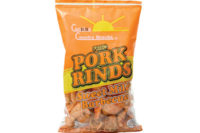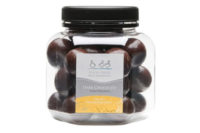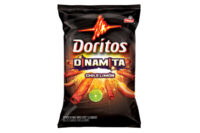Our 2013 State of the Industry report on snacks focuses on new snack products, the perspective of snack manufacturers and product leaders and market sales.
Innovative flavors and more nutritious ingredients are taking tortillas from cantinas and family kitchens to outdoor gatherings, including poolside parties. After all, what could be more refreshing on a hot summer’s day than a crisp, crunchy tortilla topped with homemade salsa or dip?
When Plano, Texas-based Frito-Lay North America, a division of PepsiCo, co-branded its popular Doritos brand with Taco Bell in March 2012, it helped revitalized the iconic tortilla chip’s position in the ultra-competitive segment.
The Taco Bell Doritos Locos Taco became Taco Bell’s most successful product launch ever, with more than 375 million sold in one year. The Cool Ranch version joined the lineup a year later. As a result, the company decided to keep the momentum going on the retail side with the creation of Doritos Locos Tacos (DLT) Tortilla Chips as a limited-time item last April. The two varieties—Nacho Cheese and Crunchy Taco Flavored Chips and Cool Ranch and Crunchy Taco Flavored Chips—are proof that there is still much potential to be tapped in this mature category.
It’s evident that tortilla chips are big business in America. U.S. tortilla/tostada chip retail sales totaled $4.2 billion, according to Information Resources, Inc. (IRI), a Chicago-based market research firm, with Doritos encompassing 43% of sales at $1.7 billion.
Ready-to-eat snacks are a dynamic category that’s experiencing healthy growth, as consumers snack more due to their busy lifestyles, which leave little time for sit-down meals. According to a recent study by The Hartman Group, 52% of Americans snack daily, up from 49% in 2010.
As consumers snack more often, they are looking for products with nutritional benefits, not just as an indulgence. “The tortilla chip category remains the second-largest snack category, but growth has been slowing in favor of new nontraditional snacks with healthier ingredients and attributes,” explains Laura Setzfand, vice president of marketing for Boulder Canyon Natural Foods, Boulder, Colo. “Gluten-free chips with beneficial nutritional profiles are showing positive growth.”
Daryl Thomas, senior vice president of sales and marketing at Nottingham, Pa-based Herr’s Foods Inc., says, “The ethnic authenticity and reach also is interesting. Consumers are more diverse in their eating experiences and ethnic appreciation. This has rolled over into the snack food segment.”
Growing strong
“The current trends show us that corn and tortilla chips are the largest and highest growth segment in the natural/organic chips and pretzel snacks space,” says Keith Dalziel, assistant marketing manager for Food Should Taste Good, a division of Minneapolis-based General Mills. “In the last year, there has been a high degree of competitive activity. New entrants and innovation are the primary drivers of change.”
Much of the category growth is coming from new segments, such as bagel and pita chips, puffed snacks, popcorn and pretzels, in addition to the established corn and tortilla chips segment.
“We are seeing an increased interest in special-occasion-type tortilla chips,” says Jeff Roberts, marketing manager at Snak King, City of Industry, Calif. The company’s Fright Bites line is a seasonal product that includes tortilla chips resembling ghosts, pumpkins and goblins. Snak King has similar offerings for Christmas as well as red, white and blue chips for July 4.
“Rolled tortilla chips are also becoming more popular, along with robust flavor offerings,” he adds.
In addition, nontraditional tortilla chips are gaining momentum, including those made from rice, bean and seed combinations to boost the nutritional profile of this snack.
But nacho cheese flavor continues to dominate the segment, though other varieties in the same genre have become popular. Snak King’s Salsa Picante, Spicy Chile N Lime and Guacamole are geared for the increasing number of consumers looking for something different. “More and more tortilla chip flavors are coming to market as well that mimic authentic Latin America cuisines,” Roberts says.
Multigrain and Sweet Potato are the best-performing flavors for Food Should Taste Good, followed by Blue Corn & Olive. The company’s Kimchi tortilla flavor launched in January, and two new dipping chips debuted at the end of May. These include Blue Corn Dipping Chips and Yellow Corn Dipping Chips.
Classic Foods Inc., San Francisco, offers both the traditional tortilla chip and a healthier version of a popped tortilla chip called Poptillas in Yellow Corn, Salsa Verde and Nacho Cheese varieties. More flavor launches are planned for the future.
Veggin’ out
“The introduction of ethnic flavors will be at the forefront,” says Roya Rohani-Cuetara, vice president of marketing at Classic Foods.
But the emphasis is mainly on incorporating healthier ingredients. Capitalizing on tortilla chips’ popularity and consumers’ focus on healthier snacking, General Mills recently debuted Green Giant Roasted Veggie Tortilla Chips in Zesty Cheddar. Made with vegetables, the naturally-flavored line has 17 g. of whole grains per serving.
While organic tortilla chips were hot a few years ago, the focus has shifted to gluten-free and nonGMO. “We are continually seeing the organic segment grow, in addition to more customers wanting to offer a nonGMO option,” Roberts says. “We are also seeing the category evolve for culturally-related reasons, as the U.S. market continues to add more and more authentic Hispanic offerings.”
Boulder Canyon offers multiple options that deliver nutritional benefits. For example, the Adzuki Bean & Rice Snack Chips available in Natural Salt and Chipotle Cheese are a good source of fiber, and Garden Select Vegetable Crisps, available in Sour Cream & Chive and Hearty Cheddar, provide 12 vegetables and more than half a serving of vegetables.
“We’re seeing more unconventional varieties and flavors across the snack food industry and that applies to tortilla chips as well,” says Setzfand. “Flavored tortilla chips have been emerging with some of the mainstream brands and spicy seems to be flowing into the trends this year. We also think there will be more natural/better-for-you chips, like our Hummus & Sesame Seeds Tortilla Chips, for the health-conscious consumer seeking nontraditional snacks that are better-for-you.”
Raising the innovation bar
Besides more healthful varieties and innovative flavors, the tortilla chip category is also seeing unique format developments. For example, Mexican Original Tortilla Chips from Tyson Deli, a Tyson Foods Inc. brand, were created for deli operators looking for a high-impulse, high-margin, fresh-snack item. Fried onsite using existing equipment, they can be marketed by stores with small fryers to prepare one or two 15-lb. cases in 30 minutes. Each case yields approximately 14 bags of chips and, once packaged, the product stays fresh for up to seven days.
The tortilla chips can be sold fresh in the service deli for up to three hours or bagged and sold by the pound throughout the store. Once packaged, operators can schedule preparation during slow frying times to keep displays full and fresh and control shrink. The chips are available in green, yellow, white, red, dark blue, black and orange colors to customize sales opportunities for local sports teams and holidays.
If it’s cantina-style tortilla chips you’re after, Herr’s Foods recently launched Herr’s Authentic Cantina-Style Tortilla Chips, thin, yellow, round chips are more akin to those served in Mexican restaurants. “It’s different than a typical snacking chip sold in the packaged goods section of the supermarket,” says Thomas.
Production advances
There also have been new developments in tortilla chip production techniques. “Concerning the special occasion tortillas, there are mainly different cutting dies to create different shapes, but beyond that, the production is the same,” says Snak King’s Roberts. “When you are talking about tortilla chips with various inclusions of grains and seeds, we mainly deal with these items on a per-case basis, and it is primarily dealing with the different variables of time, temperature and moisture.”
Newer production methods focus on healthier cooking alternatives. “Some of the new product techniques include popped tortilla chips, including pellets and popping technology, which steer away from the frying process and instead use a healthier alternative that is lower in calories and fat, but still keeps the satisfying crunch and flavor that is expected from a tortilla chip,” Rohani-Cuetara says.
Adrift with challenges
Among the biggest challenges facing the tortilla chip segment is the fight for shelf space, due to the increasing number of manufacturers and products. “The big players dominate shelf space, and this doesn’t leave much room for smaller niche brands and private-label offerings that consumers are demanding more of each year,” Roberts says. “Distribution challenges in the snack food category have always been a roadblock to many good brands out there.”
“We haven’t noticed much of a falloff in sales in the tortilla category [due to the focus on healthy eating],” Roberts continues. “Tortilla chips have a lower level of fat than most snack foods out there, and we also know that the majority of consumers buying these products are using them to dip into healthy products, such as hummus, bean dips and salsas.”
Meeting the increasing expectations as far as nonGMO and gluten-free has also been the focus for most suppliers. “The challenges include health concerns, such as an increasing awareness for nonGMO and gluten-free products, which is why we ensure that our ingredients are not genetically modified or genetically engineered. In addition, we have remained a gluten-free facility for more than two years,” says Rohani-Cuetara.
The spotlight on healthier eating also has opened a door for substituting popped chips for traditional fried items and the inclusion of functional ingredients.
“Tortilla chips with inclusions like flax, chia and vegetables continue to trend,” says Cindy Kuester, vice president of sales and marketing at Axium Foods, based in South Beloit, Ill. “Consumers are increasingly better educated about the food they eat and are vocal about wanting a larger selection of better-for-you products. Market data shows that, while this category continues to grow, the base salty snack category is still very strong. Indulging in comfort foods, which for many people is their favorite chip, still has its place.”










